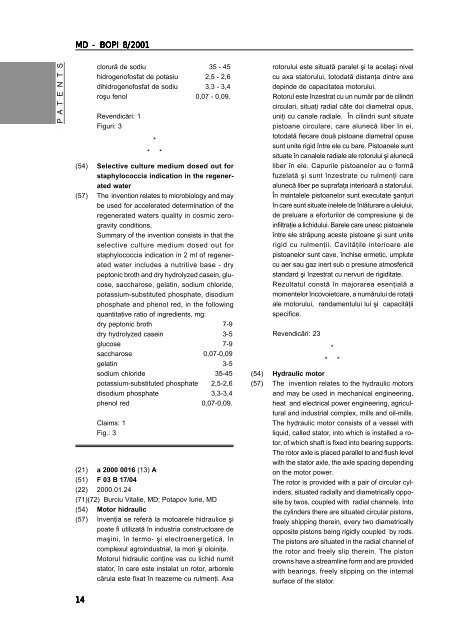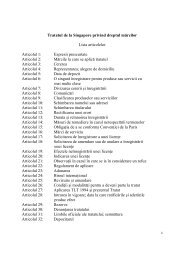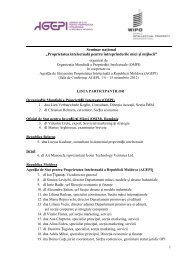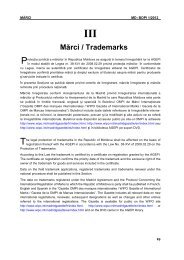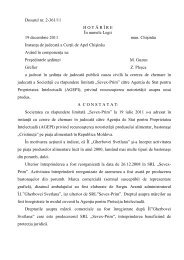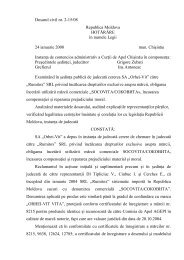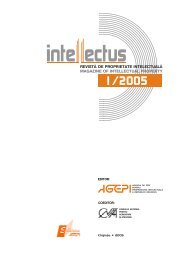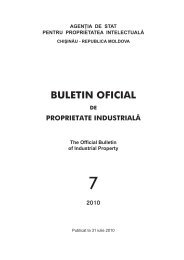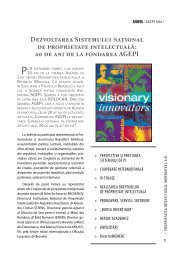BOPI in intregime - agepi
BOPI in intregime - agepi
BOPI in intregime - agepi
Create successful ePaper yourself
Turn your PDF publications into a flip-book with our unique Google optimized e-Paper software.
MD - <strong>BOPI</strong> 8/2001<br />
P A T E N T S<br />
clorură de sodiu 35 - 45<br />
hidrogenofosfat de potasiu 2,5 - 2,6<br />
dihidrogenofosfat de sodiu 3,3 - 3,4<br />
roşu fenol 0,07 - 0,09.<br />
Revendicări: 1<br />
Figuri: 3<br />
*<br />
* *<br />
(54) Selective culture medium dosed out for<br />
staphylococcia <strong>in</strong>dication <strong>in</strong> the regenerated<br />
water<br />
(57) The <strong>in</strong>vention relates to microbiology and may<br />
be used for accelerated determ<strong>in</strong>ation of the<br />
regenerated waters quality <strong>in</strong> cosmic zerogravity<br />
conditions.<br />
Summary of the <strong>in</strong>vention consists <strong>in</strong> that the<br />
selective culture medium dosed out for<br />
staphylococcia <strong>in</strong>dication <strong>in</strong> 2 ml of regenerated<br />
water <strong>in</strong>cludes a nutritive base - dry<br />
peptonic broth and dry hydrolyzed case<strong>in</strong>, glucose,<br />
saccharose, gelat<strong>in</strong>, sodium chloride,<br />
potassium-substituted phosphate, disodium<br />
phosphate and phenol red, <strong>in</strong> the follow<strong>in</strong>g<br />
quantitative ratio of <strong>in</strong>gredients, mg:<br />
dry peptonic broth 7-9<br />
dry hydrolyzed case<strong>in</strong> 3-5<br />
glucose 7-9<br />
saccharose 0,07-0,09<br />
gelat<strong>in</strong> 3-5<br />
sodium chloride 35-45<br />
potassium-substituted phosphate 2,5-2,6<br />
disodium phosphate 3,3-3,4<br />
phenol red 0,07-0,09.<br />
Claims: 1<br />
Fig.: 3<br />
(21) a 2000 0016 (13) A<br />
(51) F 03 B 17/04<br />
(22) 2000.01.24<br />
(71)(72) Burciu Vitalie, MD; Potapov Iurie, MD<br />
(54) Motor hidraulic<br />
(57) Invenţia se referă la motoarele hidraulice şi<br />
poate fi utilizată în <strong>in</strong>dustria constructoare de<br />
maş<strong>in</strong>i, în termo- şi electroenergetică, în<br />
complexul agro<strong>in</strong>dustrial, la mori şi olo<strong>in</strong>iţe.<br />
Motorul hidraulic conţ<strong>in</strong>e vas cu lichid numit<br />
stator, în care este <strong>in</strong>stalat un rotor, arborele<br />
căruia este fixat în reazeme cu rulmenţi. Axa<br />
rotorului este situată paralel şi la acelaşi nivel<br />
cu axa statorului, totodată distanţa d<strong>in</strong>tre axe<br />
dep<strong>in</strong>de de capacitatea motorului.<br />
Rotorul este înzestrat cu un număr par de cil<strong>in</strong>dri<br />
circulari, situaţi radial câte doi diametral opus,<br />
uniţi cu canale radiale. În cil<strong>in</strong>dri sunt situate<br />
pistoane circulare, care alunecă liber în ei,<br />
totodată fiecare două pistoane diametral opuse<br />
sunt unite rigid între ele cu bare. Pistoanele sunt<br />
situate în canalele radiale ale rotorului şi alunecă<br />
liber în ele. Capurile pistoanelor au o formă<br />
fuzelată şi sunt înzestrate cu rulmenţi care<br />
alunecă liber pe suprafaţa <strong>in</strong>terioară a statorului.<br />
În mantalele pistoanelor sunt executate şanţuri<br />
în care sunt situate <strong>in</strong>elele de înlăturare a uleiului,<br />
de preluare a eforturilor de compresiune şi de<br />
<strong>in</strong>filtraţie a lichidului. Barele care unesc pistoanele<br />
între ele străpung aceste pistoane şi sunt unite<br />
rigid cu rulmenţii. Cavităţile <strong>in</strong>terioare ale<br />
pistoanelor sunt cave, închise ermetic, umplute<br />
cu aer sau gaz <strong>in</strong>ert sub o presiune atmosferică<br />
standard şi înzestrat cu nervuri de rigiditate.<br />
Rezultatul constă în majorarea esenţială a<br />
momentelor încovoietoare, a numărului de rotaţii<br />
ale motorului, randamentului lui şi capacităţii<br />
specifice.<br />
Revendicări: 23<br />
*<br />
* *<br />
(54) Hydraulic motor<br />
(57) The <strong>in</strong>vention relates to the hydraulic motors<br />
and may be used <strong>in</strong> mechanical eng<strong>in</strong>eer<strong>in</strong>g,<br />
heat and electrical power eng<strong>in</strong>eer<strong>in</strong>g, agricultural<br />
and <strong>in</strong>dustrial complex, mills and oil-mills.<br />
The hydraulic motor consists of a vessel with<br />
liquid, called stator, <strong>in</strong>to which is <strong>in</strong>stalled a rotor,<br />
of which shaft is fixed <strong>in</strong>to bear<strong>in</strong>g supports.<br />
The rotor axle is placed parallel to and flush level<br />
with the stator axle, the axle spac<strong>in</strong>g depend<strong>in</strong>g<br />
on the motor power.<br />
The rotor is provided with a pair of circular cyl<strong>in</strong>ders,<br />
situated radially and diametrically opposite<br />
by twos, coupled with radial channels. Into<br />
the cyl<strong>in</strong>ders there are situated circular pistons,<br />
freely shipp<strong>in</strong>g there<strong>in</strong>, every two diametrically<br />
opposite pistons be<strong>in</strong>g rigidly coupled by rods.<br />
The pistons are situated <strong>in</strong> the radial channel of<br />
the rotor and freely slip there<strong>in</strong>. The piston<br />
crowns have a streaml<strong>in</strong>e form and are provided<br />
with bear<strong>in</strong>gs, freely slipp<strong>in</strong>g on the <strong>in</strong>ternal<br />
surface of the stator.<br />
14


